The Department of Health and Human Services (DHHS) strives to reduce cases of infections at care facilities, but with mixed results. In this study, healthcare-associated pneumonia (HCAP) was reviewed as a case of healthcare-associated infection. It was noted that it contributes largely to the increased percentage of pneumonia deaths in the US. Although guidelines for HCAP were developed in 2005, available evidence suggests that it is poorly defined, understood and may not be a suitable categorization tool for patients with multidrug-resistant (MDR) etiology. Nonetheless, it is shown that HCAP identification should be based on individual patients, local factors, and risk scoring tools for appropriate determination of HCAP and provide recommended interventions. To eliminate the current controversies, HCAP requires further studies and more evidence.
Healthcare-Associated Pneumonia
- The Department of Health and Human Services wants to eliminate healthcare-associated infections (Magill et al., 2014);
- However, healthcare-associated infections are associated with more morbidity and mortality rates;
- Some types of HAIs are difficult to eliminate.
The primary goal of the Department of Health and Human Services (DHHS) is to reduce cases of healthcare–associated infections and notably, substantial achievements in prevention have been documented for some infections (Magill et al., 2014). In this research, the focus is on healthcare-associated pneumonia (HCAP) as a healthcare-associated infection, which is poorly explored and understood.
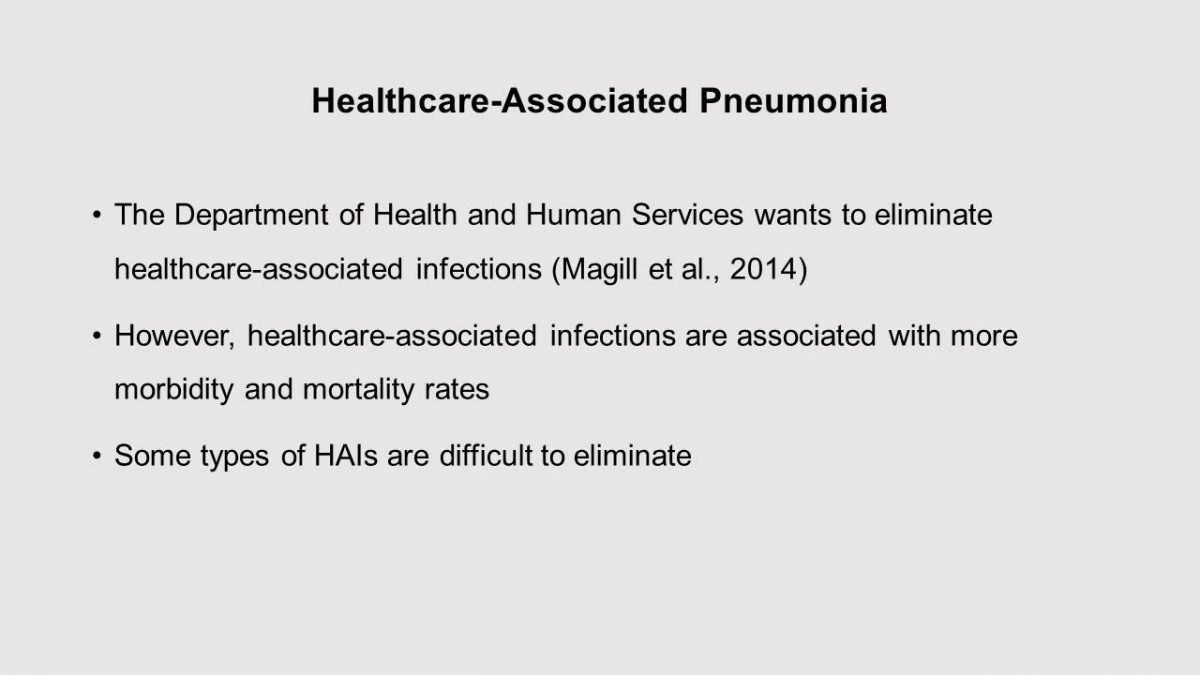
Problem Statement
- HAIs are a major cause of death in the Unified States (Rothberg et al., 2014; Russo, Falcone, Giuliano, Guastalegname, & Venditti, 2014);
- No proper treatment guideline;
- Most doctors are also not aware of the risk factors and the clinical importance of identifying them distinctly (Bo, Amprino, Dalmasso, & Zotti, 2017).
Pneumonia is the eighth major cause of death in the Unified States with a rate of case casualty approximated between 4% and 10% (Rothberg et al., 2014). The disease can be classified by the conditions under which it is acquired:
- Community-acquired pneumonia (CAP),
- Hospital-acquired pneumonia (HAP),
- Ventilator-associated pneumonia (VAP).
However, the fourth classification was introduced in 2005 by the American Thoracic Society and the Infectious Diseases Society of America (ATS/IDSA) to account for a specific group of patients with latest exposure to the healthcare services systems who are at enhanced danger of harboring multidrug-resistant organisms (MDROs) (Rothberg et al., 2014). Hence, healthcare-associated pneumonia (HCAP) was introduced to account for a poorly explored category of pneumonia, but responsible for a higher mortality rate. Based on the available evidence, patients recently in contact with the healthcare system have been identified as having increased risk of infection with MDR pathogens (Russo, Falcone, Giuliano, Guastalegname, & Venditti, 2014). However, previous studies and antimicrobial treatment recommended in guidelines for CAP did not account for HCAP. Additionally, majorities of doctors are also not aware of the risk factors associated with the HCAP and the clinical importance of identifying it from CAP.
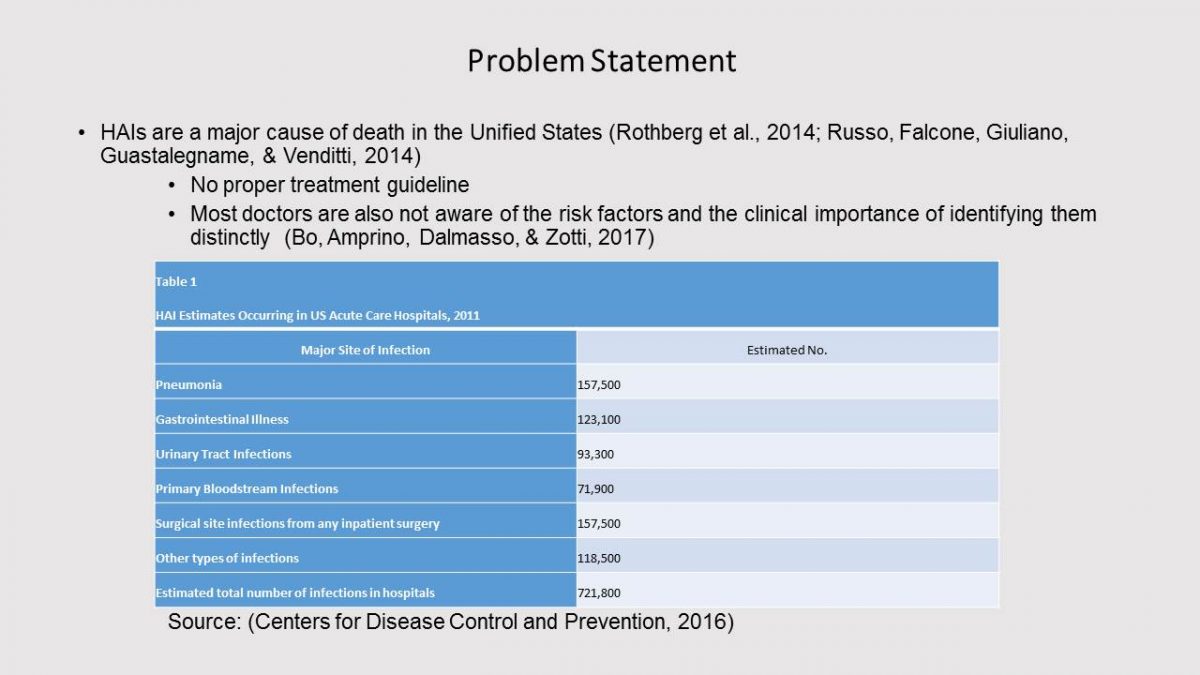
Review of the Literature
- HAIs noted as infections a patient acquires while getting health care in a care facility (Shang, Stone, & Larson, 2015; Noguchi et al., 2015; Chalmers, Rother, Salih, & Ewig, 2014; Livorsi & Eckerle, 2014; Corrao, Venditti, Argano, Russo, & Falcone, 2014);
- Interventions are mainly vertical and horizontal strategies (Septimus, Weinstein, Perl, Goldmann, & Yokoe, 2014);
- The need for enhanced surveillance (Mitchell & Russo, 2015);
- Findings demonstrate the need for a local guideline, but not a global one for intervention.
Healthcare–associated diseases (HAIs), noted as infections a patient acquires while getting health care in a care facility, are a vital patient safety challenge (Shang, Stone, & Larson, 2015). In the US, for instance, there were about 722,000 HAIs in acute care facilities, with the greater fraction of HAIs happening outside the intensive care unit (ICU). It was also estimated that on any given day, about 1 in 25 hospital patients at least reported HAI, and every year there are roughly 75,000 hospital mortality cases attributed to HAI (Shang et al., 2015). HAIs have been linked to the increased costs of care, for instance, it costs about $9.8 billion every year. Irrespective of the health burden, most cases of HAIs are actually preventable. Therefore, lessening avoidable HAIs has turned out to be one of the critical elements of action plan of the DHHS to ensure a safer and reasonable healthcare system. Moreover, it is ranked among the top issues for hospital managers in their endeavors to curtail costs of care and enhance the quality of care (Shang et al., 2015). HCAP, for instance, presents a significant challenge to care providers.
According to Noguchi et al. (2015), the causative pathogens of HCAP are still controversial, and the application of normal samples of sputum cultivation is sometimes not suitable because of the possible contamination with oral bacteria. It is likewise at times hard to decide if methicillin-resistant Staphylococcus aureus (MRSA) is an actual causative pathogen of HCAP (Noguchi et al., 2015). From the findings of Noguchi et al. (2015), it was determined that HCAP patients had heterogeneous bacteria and high incidence of streptococci relative to that observed using cultivation techniques. Moreover, the findings of the study showed a lower rate of MRSA than already expected in HCAP patients.
Some findings suggest that HCAP is a false concept derived from low-quality evidence (Chalmers, Rother, Salih, & Ewig, 2014). Chalmers et al. (2014) conducted a systematic review and meta-analysis and determined that the healthcare-associated pneumonia classification depended on low-quality evidence reinforced by bias and did not precisely indicate antibiotic-resistant pathogens. The concept of HCAP was initially proposed in the 2005 in the guidelines (Rothberg et al., 2014; Chalmers et al., 2014). It was presented as pneumonia noted in nursing home areas, patients hospitalized for at least 2 days in the past three months, patients getting home infusion interventions or wound care, and patients visiting a hemodialysis care facility in the past 30 days (Chalmers et al., 2014). The categorization of HCAP depended on the thinking that patients with successive healthcare contacts would at first need a wide range of anti-microbial treatments since they would be at higher risk for resistant pathogens (and thus higher death rates) relative to patients with no such contacts. In any case, HCAP has been uncertain, with a few specialists scrutinizing the quality of the findings while others have noted that the HCAP concept fluctuates based on the location. Subsequently, in light of these controversies, Chalmers et al. (2014) tried to demonstrate how precisely HCAP classifies patients with resistant pathogens, to assess the nature of the HCAP research findings and their potential for bias, and to approve or invalidate the HCAP categorization. According to Chalmers et al. (2014), the findings from their study do not reinforce HCAP being a reliable clinical category. The HCAP definition was less reliable at separating between patients who required antibiotic protection for MDR pathogens and the individuals who did not (Chalmers et al., 2014). It is thus sensible to presume that treating all HCAP cases in a similar fashion would prompt over treatment in locations with low MDR microbe presence and under treatment in locations with high rates. Additionally, Chalmers et al. (2014) claimed a publication bias for some studies that had surprisingly high cases of MDR microbes. Such cases destroy evidence by overstating risk linked to HCAP. In reality, the high rate of mortality in HCAP is more probably caused by old age and co-morbidities than MDR microbes. Based on the risks of wide range antibiotic agents (such as Clostridium difficile infection, advancing antibiotic resistance) and the absence of reliable findings that such a treatment enhances outcomes in HCAP, a re-evaluation of HCAP appears justified (Chalmers et al., 2014).
The findings by Chalmers et al. (2014) offer some clinical implications for nurses. The results make a solid claim for the need to comprehend the local instances of MDR microbes and to determine the most suitable treatment regimen in areas where such prevalence is high. Accordingly, it is also imperative to determine the risk factors for MDR microbes in specific patients. For instance, the MDR pathogen risk scores can be applied to assist care providers to classify risks of these microbes objectively to determine the most appropriate antibiotic treatment. The findings from this investigation bring up vital issues about the validity of the present ATS/IDSA guidelines and support the need for a re-assessment of the HCAP category of pneumonia (Chalmers et al., 2014).
The meta-analysis by Chalmers et al. (2014) has attracted attention from many other scholars interested in healthcare-associated pneumonia. It shows that the HCAP definition inadequately predicts the availability of resistant microbes. In view of these results, Chalmers et al. (2014) argue that interventions for HCAP should be guided by the local cases of MRD pathogens (Livorsi & Eckerle, 2014). In response to Chalmers et al. (2014), Livorsi and Eckerle (2014) conducted a study focusing on the need to develop a local syndromic antibiogram specific to HCAP using inpatients treated for pneumonia. They concurred with Chalmers et al. (2014) that local microbiologic data could be useful for providing a definition of HCAP that is more relevant than the current global one. Nonetheless, Livorsi and Eckerle (2014) recognized the challenges associated with developing a microbiologic diagnosis in the HCAP patient population, local guidelines can likewise be derived by checking clinical results in patients who meet the HCAP definition but treated empirically as though they have CAP infections (Livorsi & Eckerle, 2014).
Chalmers et al. (2014) further attracted much attention. It has been reviewed with extensive interests to determine its accuracy (Corrao, Venditti, Argano, Russo, & Falcone, 2014). In any case, few methodological issues must be addressed in that meta-analysis. First, Corrao et el. (2014) claim that it is extremely hard to evaluate the primary endpoint of this systematic study on the grounds that no research has been particularly intended to differentiate microbiology cases of community-acquired pneumonia (CAP) and healthcare-associated pneumonia (HCAP). Indeed, across all cases, causative microbes have been identified just in a small number of cases (Corrao et al., 2014). Just as critical is the concept that intrusive diagnostic procedures, such as bronchoscopy, have not yet been methodicallly included to verify etiologies. Therefore, it is observed that information presented in the available systematic research does not absolutely reveal whether the HCAP factor is a test for determining resistant microorganism etiologies (Corrao et al., 2014). Still, Corrao et al. (2014) note that they do not know whether HCAP itself is the most proper instrument to isolate patients with the multidrug-resistant etiology, but reliable findings show that a fraction of patients with the community-acquired pneumonia has a multidrug-resistant infection, and in most of these cases, patients satisfy the HCAP definition. The varying etiology of infections in patients exposed to care facilities have been plainly shown in different kinds of infections, including bacteremia, endocarditis, unconstrained bacterial peritonitis, and urinary tract diseases. However, pneumonia remains an uncertain issue due to the poor evidence currently available in published studies (Corrao et al., 2014).
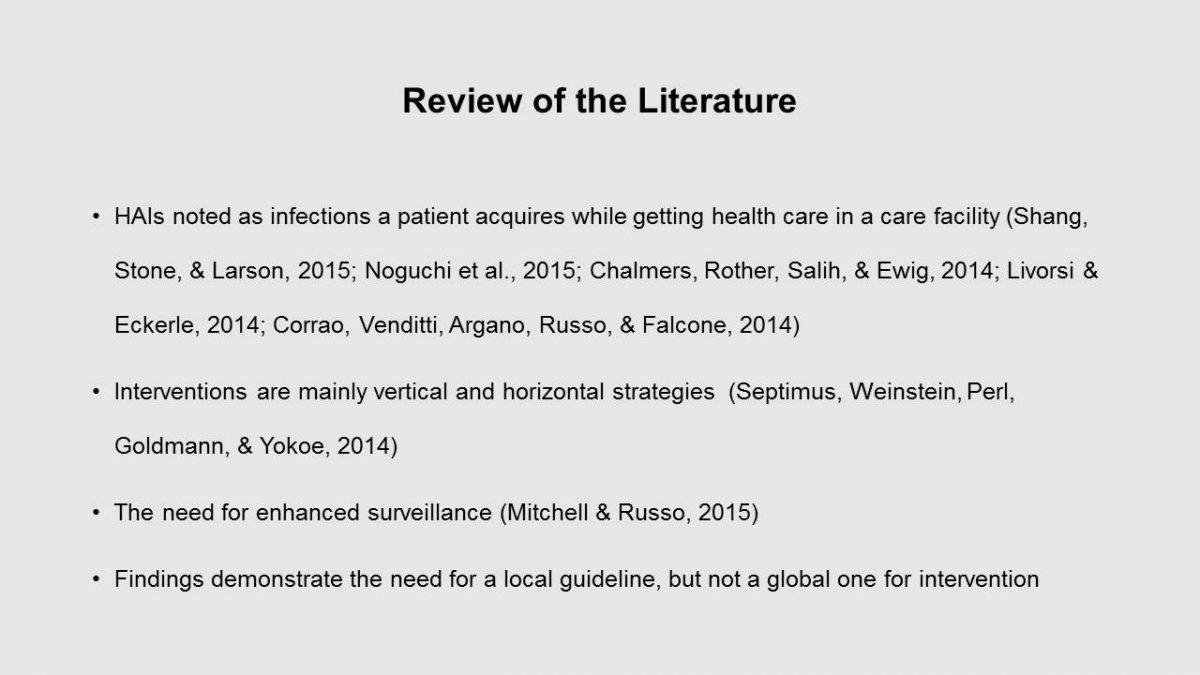
Determinants of Healthcare-Associated Pneumonia (HCAP)
- Hospitalization for 48 hours or more in the preceding 90 days;
- Residence in a nursing home or extended care facility;
- Home infusion therapy (including antibiotics and chemo);
- Hemodialysis within 30 days;
- Home wound care (Russo, Falcone, Giuliano, Guastalegname, & Venditti, 2014);
- Local factors should be patient-centered;
- HAIs common in resource-limited settings (Pathak, Singh, Jain, Dhaneria, & Lundborg, 2014).
Currently, the healthcare system has witnessed tremendous changes, which have transferred multiple aspects of care from hospital settings to community settings. Consequently, the known variations between hospital-acquired infections and community-acquired infections have become less clear. For this, more successive contacts with care facilities, patients, particularly the fragile elderly patients, have increased risks of multidrug-resistant (MDR) colonization and to acquire more serious pneumonia, with an actual risk to get ineffective empiric antibiotic treatments and, in this way, to have a severe outcome (Russo et al., 2014).
HCAP refers to pneumonia that is developed either within or outside care facilities based on the availability of risk factors for multidrug-resistant (MDR) microbes due to earlier contacts with care facilities. Specifically, risk factors have been identified as “hospitalization in the previous 90 days, residence in a nursing home, home infusion therapy, chronic dialysis, and contact with a family member harboring MDR pathogens” (Russo et al., 2014, p. 5387). Recent evidence also suggests not all HCAP patients may have increased risk of infection with MDR microbes, and the same patients may also have microbes that overlap with CAP microbes, but other do not based on the availability of risk factors. Pneumonia observed in patients following admission because a recent contact with the care facility is different from other types of pneumonia and has been classified as a distinct category, which requires a completely different approach when choosing empiric antibiotic therapies (Russo et al., 2014).
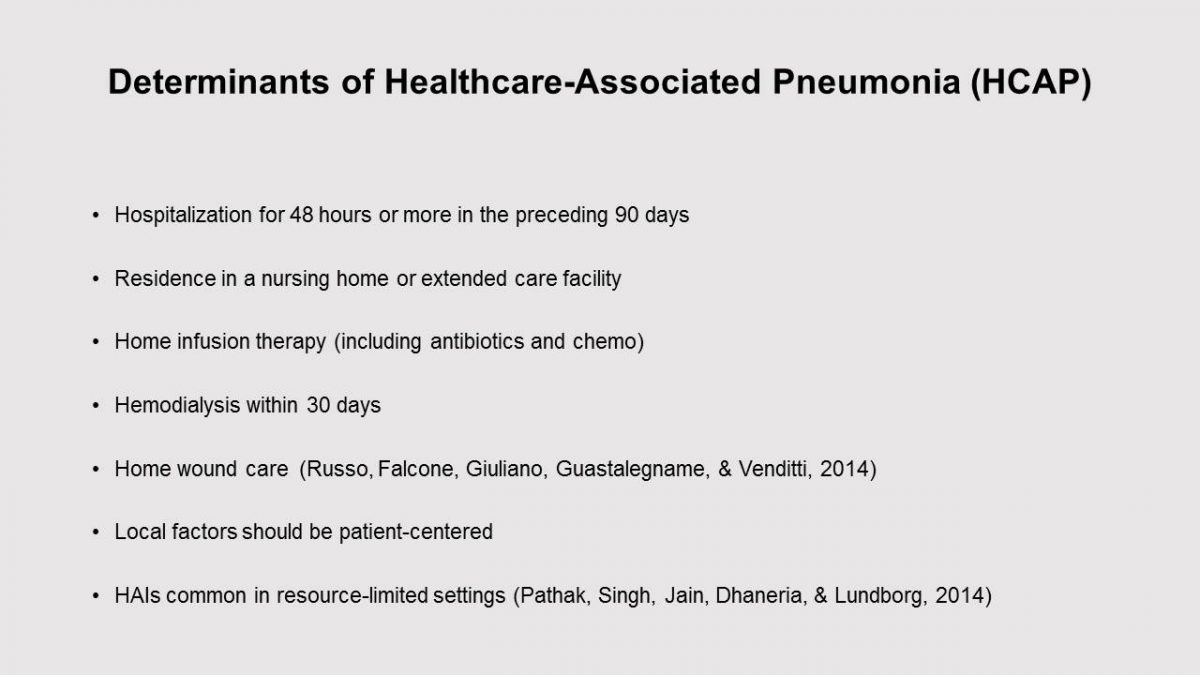
The Effectiveness of Clinical Prevention Interventions
- HAI patients tend to have outcomes that are worse than other forms of infections (Rothberg, et al., 2014).
- Some findings do not demonstrate improved outcomes among ICU patients with HAIs who received GC-HCAP therapy (Attridge et al., 2016).
- The IDSA guidelines recommend extended-spectrum antibiotic treatment and other antibiotics (Webb, Dascomb, Stenehjem, & Dean, 2015).
- An accurate, adequately validated prediction score is needed (Webb et al., 2015).
According to Rothberg et al. (2014), HCAP patients had results that were more serious than results obtained for CAP patients, even after controlling for comorbidities and demonstrating seriousness of condition, in spite of the fact that the variation looked less as other findings have shown.
Recent findings have failed to show enhanced results when guideline-concordant (GC) antibiotics are given to patients with HCAP (Attridge et al., 2016). The study by Attridge et al. (2016) was intended to assess the relation between patient outcomes and GC treatment in patients admitted to an intensive care unit (ICU) with HCAP. The study major outcome was 30-day patient mortality, and risk factors for the major result were evaluated and the findings did not show enhanced outcomes in ICU patients with HCAP who received GC-HCAP treatment (Attridge et al., 2016).
HCAP was based on the 2005 ATS/IDSA guidelines, which recommended an extended-spectrum antibiotic treatment for patients meeting HCAP criteria (Webb, Dascomb, Stenehjem, & Dean, 2015). In any case, the prescient value of the HCAP model is constrained, and evidence shows that outcomes are not enhanced following the use of HCAP guideline-concordant treatment and, thus, improved techniques to anticipate risk of CAP are required (Webb et al., 2015). Further improvement and validation of prediction scores derived from risk factors that are more thorough for CAP are required. Once a precise, satisfactorily certified prediction score is provided, its clinical importance will be assessed.
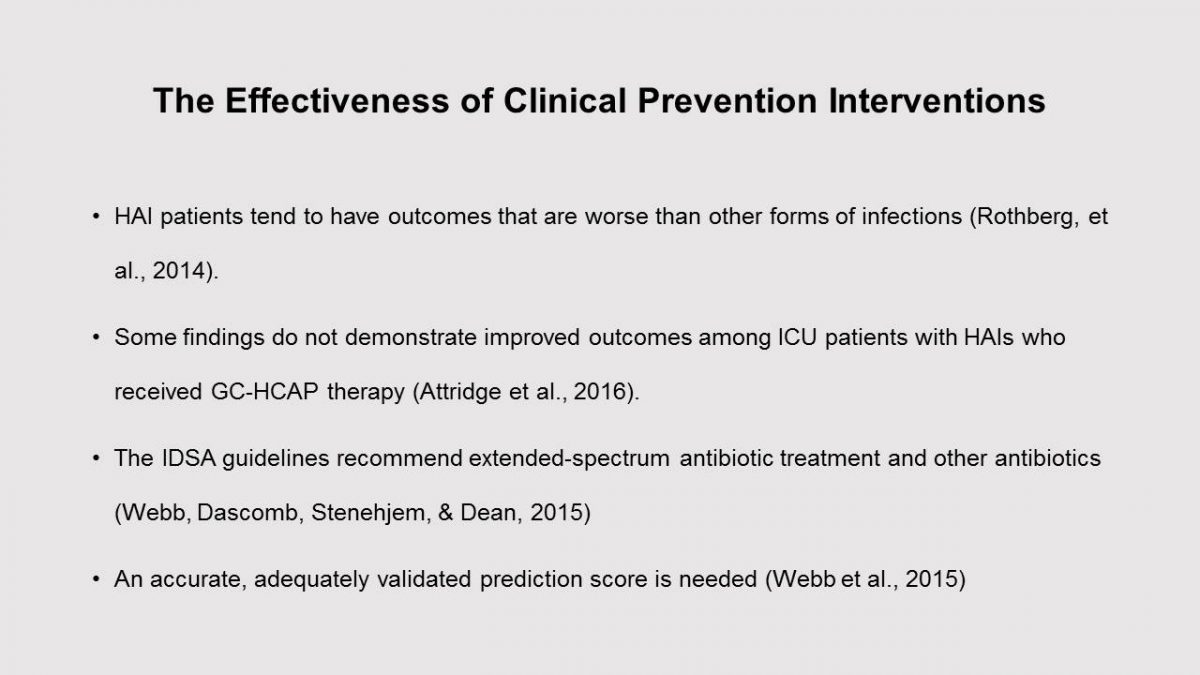
Patient-centered Strategies
- Identify vulnerable patients from the community;
- Use risk factor calculators to quantify risk for MDR pathogens;
- Determine the right antibiotic therapy (Restrepo & Aliberti, 2014);
- Evaluate patients with HAIs separately (Komiya, Ishii, & Kadota, 2015);
- Interventions should address unique needs of a patient, such as language, patient education, family engagement.
For effective patient-centered strategies, it is recommended that possibilities of pneumonia patients from the community to care facilities and have a MDR versus non-MDR pneumonia should be determined. Risk factor tools can help physicians to determine the exact risk for MDR microbes to choose the most effective antimicrobial therapy. Nonetheless, risk factor tools should be individualized to account for local epidemiology. It ought to be evident that a risk factor assessment, a microbe analysis, and a decision on the correct treatment are only few considerations for averting mortality in pneumonia patients. All assessments should be linked to specific therapies centered on stabilization of the patient’s immune response and effective management of comorbidities (Restrepo & Aliberti, 2014).
It is imperative to recognize that guidelines for pneumonia are developed based on scientific evidence and, therefore, physicians who administer therapies should account for cultural issues of their patients. HCAP may overlap with aspiration pneumonia. Hence, it is imperative to identify patients to account for HCAP sufficiently to ensure that patients with obvious repeated cases of aspiration pneumonia do not interfere with results (Komiya, Ishii, & Kadota, 2015).
The aim of patient-centered care is to account for unique needs of patients. In this case, patient education, patient knowledge, engagement of family members to ensure safety, and any concerns associated with the care provision should be sufficiently handled. Patients should also be allowed to bring their own unique perspectives and care agendas. Such engagement is advanced by developing an effective rapport and providing different instructive materials to facilitate patient involvement in care provision.
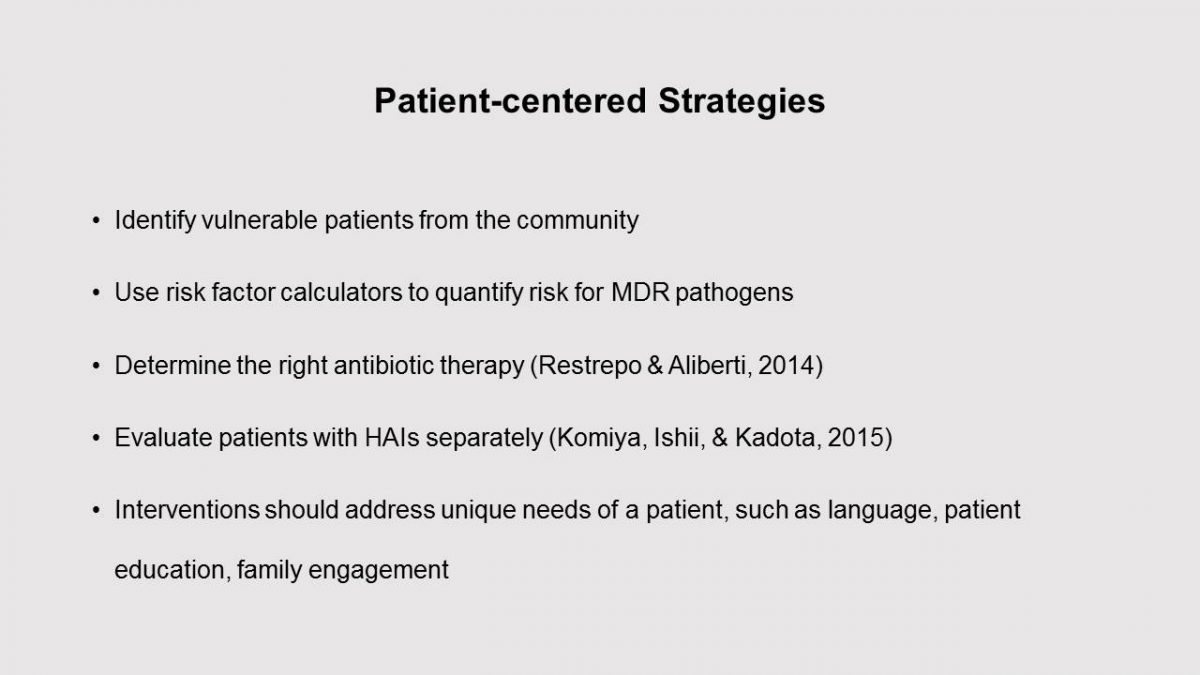
Clinical Prevention Concepts
- Based on increased risk for infection with antibiotic-resistant organisms;
- Identify risk for MRSA, multidrug-resistant pathogens, or both (Russo et al., 2014);
- Use therapeutic interventions focused on stabilization of the immune response (Restrepo & Aliberti, 2014);
- Adopt risk-scoring tools (Shorr & Zilberberg, 2015).
By developing a new guideline for HCAP pneumonia, the ATS/IDSA recognized that HCAP patients are at elevated risk for infection with MDR pathogens and the lack of antibiotic treatment or cover contributes to increased mortality. Risk factors for the advancement of pneumonia and the rise of pneumonia from medication-resistant microbes, basically methicillin-resistant Staphylococcus aureus (MRSA) and Pseudomonas aeruginosa, are not similar among the category of patients with HCAP. For instance, dialysis patients face various risks relative to nursing home patients (Shorr & Zilberberg, 2015). Besides, there is relevance heterogeneity of risk factors for HCAP within the HCAP subgroups because of differences in local factors, for example, local microbiology and strategies for providing care and differences in individual risk components, for example, status or earlier antibiotic contacts. Additionally, it is imperative to evaluate evidence for other causes of HCAP, such as possible risk factors for cases of pneumonia drug resistance. Thus, the intervention should always focus on patients at greater risk for HCAP. Still, within the scope of pneumonia infections, care providers should always ensure that they account for different types of pneumonia based on types of risk, including MRSA and possible resistance to drugs.
Researchers have developed different risk scoring devices to categorize patients based on the probability that their infection has emanated from pathogen, for example, methicillin-resistant S. aureus or P. aeruginosa (Shorr & Zilberberg, 2015). Results from the scoring tools give accurate means to isolate patients on the premise of the possible recuperation from resistant microbes than does the HCAP infection. The vast majority of these risk-scoring tools are simple to compute and use, and a few have been independently tested for validity (Shorr & Zilberberg, 2015). Overall, effective care requires care providers to consider using these instruments in their strategies to handle patients with HCAP pneumonia infections.
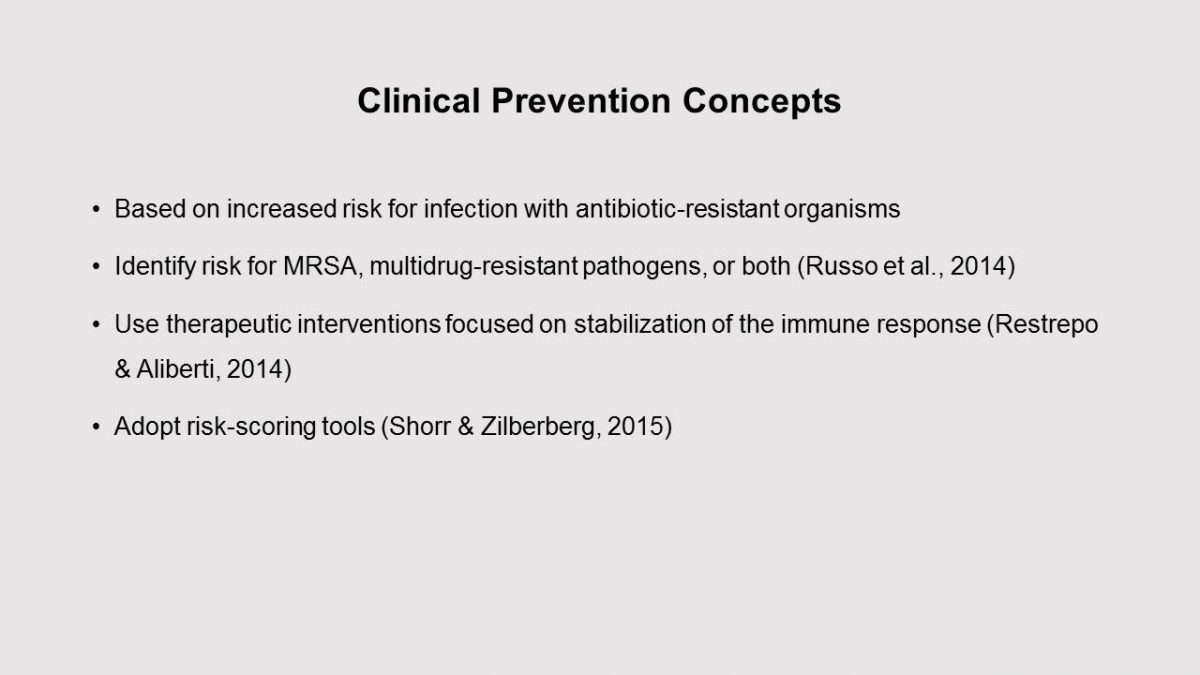
Conclusion
- Healthcare-associated infections are major causes of deaths;
- Risk factors indicate that patients are at higher risks for mortality;
- Significant improvements have been noted, but enhanced surveillance, horizontal and vertical intervention strategies are required;
- Patient-centered treatment and the use of risk-scoring tools to stratify patients are imperative for effective interventions.
Pneumonia is among the major killers in the US, and it is among the most common healthcare-associated infections. For HCAP, the ATS/IDSA recognized deaths related with it and in 2005, it developed guidelines to ensure quality care and outcomes. However, certain findings show that HCAP is controversial because of its definition and supporting evidence. Hence, it is not an appropriate category of pneumonia, but some results have supported this category of pneumonia. Nonetheless, HCAP requires further studies to support its classification, patient-centered care, effective interventions, and reliable risk assessment tools.
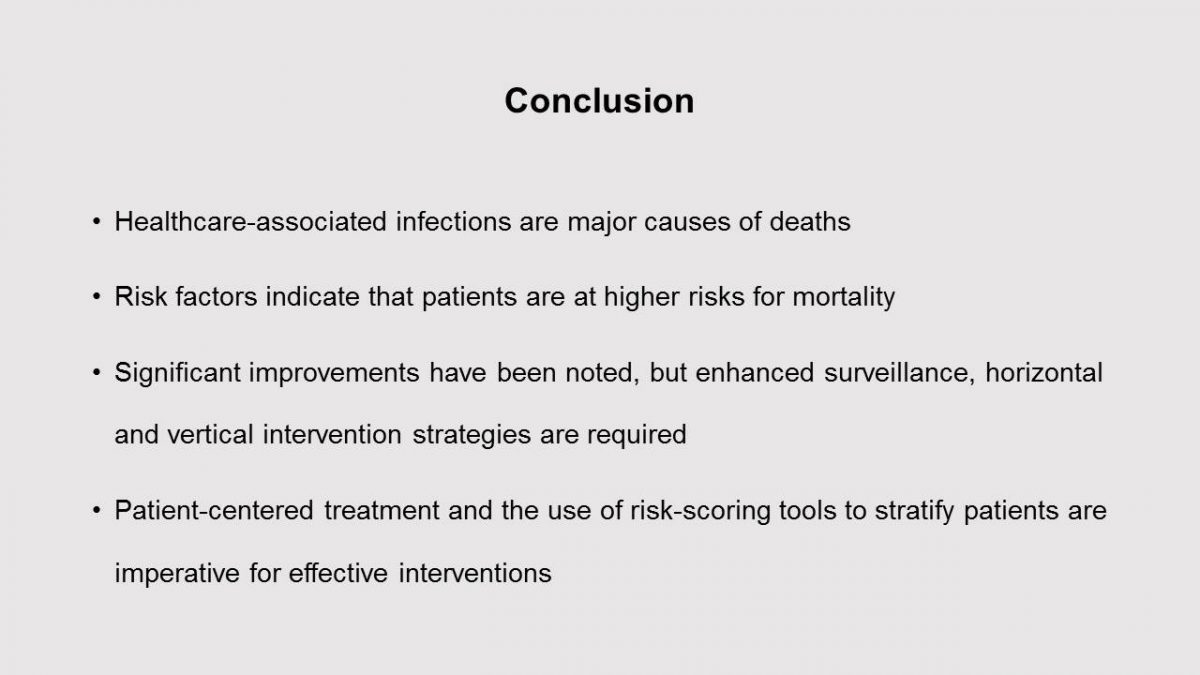
References
Attridge, R. T., Frei, C. R., Pugh, M. J., Lawson, K. A., Ryan, L., Anzueto, A., . . . Mortensen, E. M. (2016). Health care–associated pneumonia in the intensive care unit: Guideline-concordant antibiotics and outcomes. Journal of Critical Care, 36, 265–271.
Bo, M., Amprino, V., Dalmasso, P., & Zotti, C. M. (2017). Delivery of written and verbal information on healthcare- associated infections to patients: Opinions and attitudes of a sample of healthcare workers. BMC Health Services Research, 17, 66.
Centers for Disease Control and Prevention. (2016). HAI Data and Statistics. Web.
Chalmers, J. D., Rother, C., Salih, W., & Ewig, S. (2014). Healthcare-associated pneumonia does not accurately identify potentially resistant pathogens: A systematic review and meta-analysis. Clinical Infectious Diseases, 58(3), 330-339.
Corrao, S., Venditti, M., Argano, C., Russo, A., & Falcone, M. (2014). Healthcare-associated pneumonia and multidrug-resistant bacteria: Do we have a convincing answer? Clinical Infectious Diseases, 58(8), 1196-1197.
Komiya, K., Ishii, H., & Kadota, J.-i. (2015). Healthcare-associated pneumonia and aspiration pneumonia. Aging & Disease, 6(1), 27–37.
Livorsi, D., & Eckerle, M. K. (2014). Developing local treatment guidelines for healthcare-associated pneumonia. Clinical I nfectious Diseases, 59(4), 609-610.
Mitchell, B. G., & Russo, P. L. (2015). Preventing healthcare-associated infections: The role of surveillance. Nursing Standard, 29(23), 52-58.
Magill, S. S., Edwards, J. R., Bamberg, W., Beldavs, Z. G., Dumyati, G., Kainer, M. A., . . .Fridkin, S. K. (2014). Multistate point-prevalence survey of health care–associated infections. The New England Journal of Medicine, 370(13), 1198-208.
Noguchi, S., Mukae, H., Kawanami, T., Yamasaki, K., Fukuda, K., Akata, K., . . . Yatera, K. (2015). Bacteriological assessment of healthcare-associated pneumonia using a clone library analysis. PLoS ONE, 10(4), e0124697.
Pathak, A., Singh, P., Jain, S., Dhaneria, M., & Lundborg, C. S. (2014). Incidence and determinants of health care associated blood stream infections at a neonatal intensive care unit in Ujjain, India: Results of a prospective cohort study. International Journal of Infectious Diseases, 21(S1), 48.
Restrepo, M. I., & Aliberti, S. (2014). Healthcare-associated pneumonia: Where do we go next? Clinical Infectious Diseases, 58(3), 340–341.
Rothberg, M. B., Haessler, S., Lagu, T., Lindenauer, P. K., Pekow, P. S., Priya, A., . . . Zilberberg, M. D. (2014). Outcomes of patients with healthcare- associated pneumonia: Worse disease or sicker patients? Infection Control and Hospital Epidemiology, 35(S3), S107-S115.
Russo, A., Falcone, M., Giuliano, S., Guastalegname, M., & Venditti, M. (2014). Healthcare-associated pneumonia: A never-ending story. Infectious Disease Reports, 6(2).
Septimus, E., Weinstein, R. A., Perl, T. M., Goldmann, D. A., & Yokoe, D. S. (2014). Approaches for preventing healthcare-associated infections: Go long or go wide? Infection Control and Hospital Epidemiology, 35(7), 797-801.
Shang, J., Stone, P., & Larson, E. (2015). Studies on nurse staffing and healthcare associated infection: Methodological challenges and potential solutions. American Journal of Infection Control, 43(6), 581–588.
Shorr, A. F., & Zilberberg, M. D. (2015). Role for risk-scoring tools in identifying resistant pathogens in pneumonia: Reassessing the value of healthcare- associated pneumonia as a concept. Current Opinion in Pulmonary Medicine, 21(3), 232–238.
Webb, B. J., Dascomb, K., Stenehjem, E., & Dean, N. (2015). Predicting risk of drug-resistant organisms in pneumonia: Moving beyond the HCAP model. Respiratory Medicine, 109(1), 1-10.